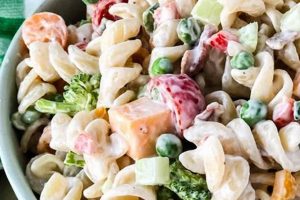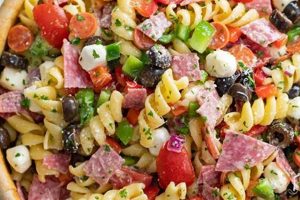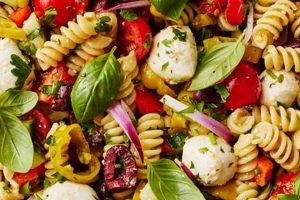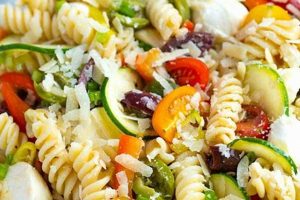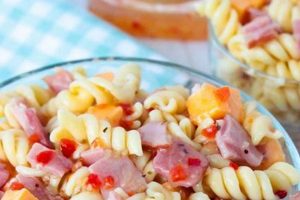A chilled dish featuring ring-shaped, stuffed pasta combined with various ingredients like vegetables, cheeses, meats, and a flavorful dressing constitutes this culinary creation. Examples include combinations such as spinach tortellini with pesto, sun-dried tomatoes, and artichoke hearts, or cheese tortellini with Italian dressing, salami, olives, and bell peppers.
This type of dish offers a versatile and convenient meal option. Its adaptability allows for customization to individual preferences and dietary needs, incorporating a wide array of fresh, seasonal produce. The chilled nature makes it ideal for warm weather gatherings or as a make-ahead meal for busy schedules. Furthermore, it often presents a balanced nutritional profile, incorporating carbohydrates, protein, and healthy fats, depending on the chosen ingredients.
This exploration will delve into diverse variations, covering ingredient selection, dressing options, preparation techniques, and tips for successful presentation. Further discussion will address considerations for dietary restrictions and offer creative suggestions for elevating this dish to new culinary heights.
Tips for Creating Exceptional Tortellini Pasta Salad
Achieving a well-balanced and flavorful pasta salad requires attention to detail. These tips offer guidance for optimizing ingredient selection, preparation methods, and presentation.
Tip 1: Cook Tortellini Perfectly: Slightly undercook the pasta to maintain its texture when chilled. Rinse with cold water immediately after draining to stop the cooking process and prevent sticking.
Tip 2: Embrace Fresh, High-Quality Ingredients: Opt for vibrant, seasonal vegetables and flavorful cheeses. High-quality ingredients contribute significantly to the overall taste and aesthetic appeal.
Tip 3: Dress Strategically: Add the dressing shortly before serving to prevent the pasta from absorbing too much and becoming soggy. Toss gently to ensure even coating.
Tip 4: Consider Flavor Combinations: Complementary flavor profiles enhance the dish. Pair Italian dressing with Mediterranean vegetables and cheeses, or pesto with sun-dried tomatoes and artichoke hearts.
Tip 5: Balance Textures: Incorporate a variety of textures to create a more engaging culinary experience. Combine soft cheese with crisp vegetables and crunchy nuts.
Tip 6: Chill Thoroughly: Allow the salad to chill for at least one hour before serving. This allows the flavors to meld and enhances the refreshing qualities of the dish.
Tip 7: Garnish Thoughtfully: A final garnish elevates presentation. Consider fresh herbs, a sprinkle of cheese, or a drizzle of olive oil.
By following these tips, one can consistently produce a delicious and visually appealing pasta salad suitable for various occasions. Attention to these details ensures a satisfying culinary outcome.
These insights provide a foundation for successful preparation. The subsequent conclusion will offer final thoughts and encourage culinary exploration.
1. Tortellini Variety
Tortellini variety plays a pivotal role in shaping the overall character of pasta salad recipes. Different fillings offer distinct flavor profiles, influencing the choice of complementary ingredients and dressings. Cheese-filled tortellini, for example, provides a mild, creamy base, suitable for pairings with bolder flavors like pesto or sun-dried tomatoes. Spinach tortellini lends an earthy note, harmonizing well with lighter dressings and ingredients like artichoke hearts and lemon vinaigrette. Meat-filled tortellini, such as those with prosciutto or sausage, introduces a savory richness, often paired with robust vegetables and Italian dressing. This careful consideration of tortellini variety establishes a foundational flavor profile, impacting the recipe’s overall success.
The selection of tortellini also influences the nutritional value and dietary suitability of the salad. Cheese tortellini contributes dairy, while spinach tortellini adds iron and vitamins. Meat-filled varieties offer a source of protein. Understanding these nuances allows for customization to specific dietary needs and preferences. For instance, a vegetarian pasta salad might utilize cheese or spinach tortellini, while a heartier salad could incorporate meat-filled tortellini alongside grilled chicken or salami.
In conclusion, the choice of tortellini variety serves as a crucial starting point in crafting a well-balanced and flavorful pasta salad. Careful consideration of the filling’s flavor profile, nutritional content, and compatibility with other ingredients ensures a successful and satisfying culinary outcome. This understanding allows for creativity and customization, resulting in a diverse range of pasta salad options tailored to individual tastes and dietary requirements.
2. Fresh Ingredients
Fresh ingredients are essential for elevating tortellini pasta salad recipes beyond simple convenience food to vibrant, flavorful dishes. Ingredient quality directly impacts the overall taste, texture, and nutritional value. Freshness enhances the vibrancy of flavors, contributing to a more satisfying culinary experience. The following facets explore the crucial role of fresh ingredients in crafting exceptional tortellini pasta salads.
- Seasonal Vegetables
Seasonal vegetables provide optimal flavor and nutritional value. Summer tomatoes, for example, offer a sweetness and juiciness unmatched by their out-of-season counterparts. Incorporating seasonal produce like crisp cucumbers, bell peppers, and zucchini enhances both the taste and visual appeal of the salad. Choosing vegetables at their peak freshness contributes significantly to the overall quality of the dish.
- Aromatic Herbs
Fresh herbs contribute brightness and complexity to pasta salad. Basil, parsley, and oregano offer distinct aromatic notes that complement the other ingredients. Freshly chopped herbs, as opposed to dried, provide a more vibrant flavor and enhance the sensory experience. Their inclusion elevates the salad beyond basic ingredients, adding depth and complexity.
- High-Quality Cheese
The choice of cheese significantly influences the overall flavor profile. Fresh mozzarella, crumbled feta, or shaved Parmesan offer distinct textures and tastes. High-quality cheeses contribute a richness and depth that enhances the other ingredients. Using freshly grated cheese, rather than pre-shredded, provides a superior flavor and texture, contributing to a more refined culinary result.
- Proper Storage
Maintaining ingredient freshness requires proper storage. Storing vegetables and herbs in airtight containers in the refrigerator preserves their quality and prevents premature spoilage. Proper handling and storage ensure that ingredients retain their optimal flavor and texture, contributing to a more enjoyable and flavorful pasta salad.
The careful selection and handling of fresh ingredients are crucial for achieving a superior tortellini pasta salad. Prioritizing freshness elevates the dish from ordinary to extraordinary, creating a more vibrant and satisfying culinary experience. By incorporating high-quality, seasonal ingredients and employing proper storage techniques, one ensures a flavorful and visually appealing salad that showcases the best of each component.
3. Complementary Dressing
Dressing selection significantly impacts the overall flavor profile of tortellini pasta salad. A complementary dressing harmonizes with the chosen tortellini filling and other ingredients, creating a cohesive and balanced culinary experience. An inappropriate dressing can overwhelm delicate flavors or clash with bolder ones. The following facets explore the crucial role of complementary dressings in successful tortellini pasta salad recipes.
- Flavor Pairing
The dressing’s flavor profile should complement the tortellini filling and other ingredients. For instance, a light vinaigrette enhances the delicate flavors of cheese tortellini and fresh vegetables, while a creamy pesto complements spinach tortellini and sun-dried tomatoes. A robust Italian dressing pairs well with meat-filled tortellini and bolder ingredients like olives and peppers. Careful consideration of flavor pairings ensures a harmonious balance.
- Texture Consideration
Dressing texture contributes to the overall sensory experience. A creamy dressing adds richness and coats the pasta evenly, while a vinaigrette provides a lighter, brighter touch. The chosen texture should complement the other ingredients. A creamy dressing might overwhelm a salad with delicate ingredients, while a vinaigrette might not cling well to heavier pasta shapes. Balancing textures ensures a more satisfying culinary outcome.
- Acidity Level
Acidity plays a crucial role in balancing richness and adding brightness. Vinaigrettes offer a tangy counterpoint to creamy cheeses and rich meats, while creamy dressings can mellow the acidity of certain vegetables like tomatoes. The acidity level should be balanced with the other flavors to prevent the salad from becoming overly tart or bland. Careful adjustment of acidity ensures a well-rounded flavor profile.
- Homemade vs. Store-Bought
Both homemade and store-bought dressings offer advantages. Homemade dressings allow for complete control over ingredients and customization of flavors. Store-bought dressings provide convenience, but ingredient lists and quality should be carefully considered. Ultimately, the best choice depends on individual preferences and time constraints. Both options can contribute to a successful pasta salad when chosen thoughtfully.
Complementary dressing selection elevates tortellini pasta salad from a simple dish to a carefully composed culinary creation. A well-chosen dressing unifies the flavors, creating a harmonious and balanced experience. By considering flavor pairings, texture, acidity, and the option of homemade versus store-bought, one ensures a dressing that enhances the tortellini and other ingredients, resulting in a truly satisfying pasta salad.
4. Flavorful Add-ins
Flavorful add-ins elevate tortellini pasta salad recipes from simple fare to complex and satisfying meals. These additions introduce textural contrast, depth of flavor, and visual appeal, transforming a basic pasta salad into a culinary experience. Strategic incorporation of add-ins allows for customization and creativity, catering to individual preferences and dietary needs. The following facets explore the integral role of flavorful add-ins in crafting exceptional tortellini pasta salads.
- Cured Meats
Cured meats contribute a savory, salty dimension to pasta salad. Salami, prosciutto, and pepperoni introduce complex flavors and textural contrast. Their inclusion complements the richness of cheese-filled tortellini and provides a protein element. For instance, diced salami adds a spicy kick, while thinly sliced prosciutto offers a delicate saltiness. The choice of cured meat depends on the desired flavor profile and overall balance of the salad.
- Artisan Cheeses
Artisan cheeses introduce nuanced flavors and textures beyond basic mozzarella or Parmesan. Crumbled feta, goat cheese, or shaved Pecorino Romano add depth and complexity. These cheeses complement the creamy texture of tortellini and enhance the overall richness of the salad. For example, feta provides a salty tang, while goat cheese offers a creamy earthiness. The selection of artisan cheese depends on desired flavor pairings and overall balance.
- Vibrant Vegetables
Beyond standard salad vegetables, incorporating roasted or marinated vegetables adds depth and complexity. Roasted red peppers, marinated artichoke hearts, or grilled zucchini introduce smoky, tangy, or charred notes, respectively. These additions provide textural contrast and visual appeal, elevating the salad beyond basic ingredients. The choice of vegetables should consider seasonal availability and flavor compatibility with other components.
- Nuts and Seeds
Nuts and seeds contribute a satisfying crunch and enhance the nutritional value of the salad. Toasted pine nuts, slivered almonds, or sunflower seeds add textural contrast and healthy fats. Their inclusion complements the creamy tortellini and provides a satisfying element to each bite. The choice of nuts or seeds should consider flavor pairings and overall balance, ensuring they enhance rather than overpower the other ingredients.
Flavorful add-ins are essential for crafting exceptional tortellini pasta salads. Their strategic incorporation elevates the dish from simple to sophisticated, offering a complex interplay of flavors, textures, and visual appeal. By thoughtfully selecting and combining add-ins, one can create a customized pasta salad experience that caters to individual preferences and elevates the culinary enjoyment.
5. Proper Chilling Time
Proper chilling time is crucial for tortellini pasta salad recipes, significantly influencing flavor development and overall enjoyment. Chilling allows the flavors of the various ingredientsthe pasta, vegetables, cheeses, meats, and dressingto meld and harmonize. This melding creates a more cohesive and balanced flavor profile than a freshly tossed salad. A chilled salad also offers a more refreshing culinary experience, particularly in warm weather. For instance, a tortellini pasta salad with pesto, sun-dried tomatoes, and artichoke hearts benefits significantly from chilling, allowing the pesto to permeate the other ingredients and the flavors to deepen.
The duration of chilling impacts the final result. Insufficient chilling may result in a bland or disjointed flavor profile, while excessive chilling can lead to certain ingredients, such as tomatoes, becoming mealy. Generally, a chilling time of one to two hours allows for optimal flavor development without compromising texture. However, salads with robust flavors, like those incorporating cured meats or strong cheeses, may benefit from a longer chilling period. Conversely, salads with delicate flavors may require less chilling time. Adjusting chilling time based on the specific recipe ensures optimal flavor and texture.
Understanding the impact of proper chilling time is essential for successful tortellini pasta salad preparation. This crucial step elevates the dish beyond a simple combination of ingredients to a cohesive and flavorful culinary experience. The chilling process allows individual flavors to harmonize, resulting in a more complex and satisfying final product. Careful consideration of chilling time based on recipe components ensures optimal flavor development and texture, contributing significantly to the overall success of the dish.
6. Creative Presentation
Creative presentation elevates tortellini pasta salad from a simple dish to a visually appealing culinary creation. Thoughtful plating and garnishing enhance the dining experience, stimulating appetite and adding a touch of elegance. While flavor remains paramount, visual appeal plays a significant role in overall enjoyment. Strategic presentation techniques transform a basic pasta salad into a visually engaging centerpiece.
- Serving Platters and Bowls
The choice of serving vessel significantly impacts presentation. A large, shallow platter showcases the vibrant colors and textures of the salad, allowing for artistic arrangement of ingredients. Alternatively, individual bowls offer a more formal presentation, ideal for portion control and catered events. Glass bowls highlight the layers and colors of the salad, while rustic wooden bowls offer a more casual aesthetic. The serving vessel should complement the overall style and occasion.
- Garnishing Techniques
Garnishes provide a finishing touch that enhances visual appeal and adds bursts of flavor. Fresh herbs, such as basil or parsley, provide vibrant green accents and aromatic notes. A sprinkle of grated Parmesan cheese adds a touch of richness and visual texture. A drizzle of olive oil or balsamic glaze adds a glossy sheen and enhances flavor complexity. Garnishes should complement the existing flavors and colors of the salad without overpowering the main components.
- Layering and Arrangement
Strategic layering and arrangement of ingredients enhance visual depth and texture. Larger ingredients, such as halved cherry tomatoes or cucumber slices, can be arranged around the perimeter of the platter, creating a frame for the tortellini and smaller components. Creating height in the center of the salad adds visual interest. Thoughtful arrangement showcases the variety of ingredients and creates a more appealing presentation.
- Color and Contrast
Utilizing contrasting colors and textures creates a visually dynamic presentation. The vibrant colors of fresh vegetables, such as red bell peppers, green spinach, and yellow squash, create a visually appealing contrast against the creamy tortellini. Incorporating ingredients with varying textures, such as crunchy nuts or croutons, adds visual interest and enhances the sensory experience. A balance of colors and textures creates a more engaging and appetizing presentation.
Creative presentation enhances the enjoyment of tortellini pasta salad, transforming it from a simple side dish to a visually appealing centerpiece. Careful consideration of serving vessels, garnishing techniques, layering, and color contrast elevates the dining experience, making the salad as pleasing to the eye as it is to the palate. These techniques demonstrate that visual appeal plays a significant role in the overall enjoyment of food, complementing the delicious flavors and textures of a well-crafted tortellini pasta salad.
Frequently Asked Questions
This section addresses common inquiries regarding the preparation and enjoyment of tortellini pasta salad.
Question 1: How long can tortellini pasta salad be stored in the refrigerator?
Properly stored tortellini pasta salad typically remains safe to consume for three to five days in the refrigerator. Spoilage signs include a sour odor, slimy texture, or mold growth.
Question 2: Can tortellini pasta salad be frozen?
Freezing is not generally recommended, as it can negatively impact the texture of the pasta and vegetables, resulting in a mushy consistency upon thawing. The dressing may also separate, leading to an undesirable texture.
Question 3: What are some vegetarian-friendly protein options for tortellini pasta salad?
Chickpeas, cannellini beans, or cubed firm tofu offer plant-based protein alternatives to meat in vegetarian tortellini pasta salad. These options complement the pasta and vegetables while contributing nutritional value.
Question 4: How can one prevent tortellini pasta salad from becoming soggy?
Adding the dressing shortly before serving helps prevent the pasta from absorbing excessive moisture. Ensuring the tortellini is cooked al dente and rinsed with cold water also minimizes sogginess.
Question 5: What are some gluten-free alternatives for tortellini pasta salad?
Gluten-free tortellini, made from rice flour, corn flour, or other gluten-free alternatives, can be used to create a gluten-free version. Alternatively, salads using quinoa, rice, or other gluten-free grains can offer similar flavors and textures.
Question 6: How can one adjust the flavor intensity of tortellini pasta salad?
Adjusting the amount of dressing, adding more or less of certain ingredients like herbs or spices, or incorporating a splash of lemon juice or vinegar allows for customization of flavor intensity. Tasting and adjusting incrementally ensures a balanced and desirable flavor profile.
This FAQ section has addressed key concerns regarding tortellini pasta salad, providing insights into storage, ingredient selection, and flavor adjustment. These points ensure successful preparation and enjoyment.
The following section will offer a concluding summary of the discussed topics and encourage further culinary exploration.
Conclusion
Exploration of tortellini pasta salad recipes reveals a dish offering versatility and culinary potential. Emphasis on fresh ingredients, complementary dressings, and flavorful add-ins underscores the capacity for customization and flavor complexity. Proper chilling time and creative presentation techniques further enhance the sensory experience, transforming a simple pasta salad into a visually appealing and flavorful dish suitable for diverse occasions. Careful consideration of these elements ensures consistent culinary success.
The adaptability of tortellini pasta salad recipes encourages culinary creativity and exploration. Potential for incorporating seasonal ingredients and diverse flavor profiles offers ongoing opportunities for culinary innovation. This adaptability ensures continued relevance and enjoyment across varied palates and dietary preferences. Further experimentation with ingredients and techniques promises continued evolution and discovery within this culinary domain.

